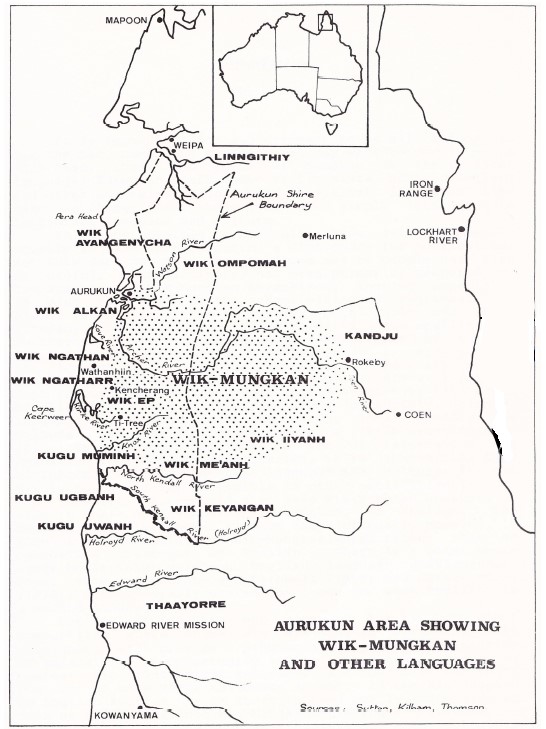Wik-Mungkan is an Aboriginal language mostly spoken in Aurukun on west coast of the Cape York Peninsula in Queensland, Australia. Wik-Mungkan can be classified as a Middle Paman language, and the language was historically spoken inland in a large area between the Archer and Edward rivers, with the only coastal connection being where Aurukun is now located. The map below shows the area traditionally associated with Wik-Mungkan.
 |
|---|
| Map of Cape York (source: Kilham, C., Pamulkam, M., Pootchemunka, M., Wolmby, T., Adams, J., Bell, J., & Namponan, G. (1986). Dictionary and sourcebook of the Wik-Mungkan language: Summer Institute of Linguistics, Australian Aborigines Branch.) |
The language is spoken by Wik-Mungkan people and used as a lingua franca in the area by related groups of the area (e.g. Wik-Ngathan, Wikalken, Kugu Nganhcara, Kugu Muminh, etc.). Nowadays, most members of these group speak Wik-Mungkan as their first language. There are approximately 1000 speakers of Wik-Mungkan, and children are still learning Wik-Mungkan as their first language.
Aurukun town was established in 1904 as a Lutheran mission and is now the largest Indigenous community in the Western Cape York Peninsula. The country around Aurukun is coastal alluvial flood plains. Significant landscape features are low sandy ridges going parallel to the coast, allowing travel in the wet season, and the big river systems of the area. In the area around Aurukun, swamps, estuaries, mangrove, and woodland surround the town, and has historically been the types of environments exploited economically, in favour of going out to sea. Language, clan, and country are highly interconnected for people in Aurukun; different languages and clans are related to specific areas of Country in the area.
Wik-Mungkan is one of the languages constituting the sociotopographic study in the OzSpace project. The goal of the Wik-Mungkan project is to document and describe how speakers of Wik-Mungkan talk about spatial relations and how they interact with the environment, while also looking at whether there is any variation in the grammar of spatial reference in the community.
Laurits Stapput Knudsen (PhD Candidate at the University of Newcastle) is collaborating with members of the community and local organisations in data collection and analysis for this sub-project.